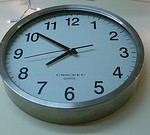 I’m trying to achieve success at work, and you can too! For the next 4 weeks, I’ll be running a #SuccessAtWork challenge on this blog. Each week’s challenge will follow one of the 7 disciplines I highlight in my new ebook, What the Most Successful People Do at Work. If you’re participating, please let me know in the comments, or on Twitter.
I’m trying to achieve success at work, and you can too! For the next 4 weeks, I’ll be running a #SuccessAtWork challenge on this blog. Each week’s challenge will follow one of the 7 disciplines I highlight in my new ebook, What the Most Successful People Do at Work. If you’re participating, please let me know in the comments, or on Twitter.
What is work? In my ebook, I try to make a distinction between activities that are advancing you and your organization toward your goals, and those that are not. In a world where being “busy” is seen as valuable, it’s always tempting to load up the calendar with more meetings, more calls, more projects. But what is the payoff? Time is a non-renewable resource, and all time has an opportunity cost.
I was reminded of this recently while cleaning out my desk. I came across a number of old work notebooks containing old to-do lists. Reading through them has been like a version of “This is Your Life.” Curiously, I came across two other assignments that involved interviewing LeUyen Pham, the children’s book illustrator whose story leads off What the Most Successful People Do at Work. In some ways, this reminds me of the inherently fraught nature of figuring out what activities are advancing you toward your professional goals, and what are not. I wrote a profile of her for a website that I never wrote for again. Was that a waste? On one hand, yes. I had all the start-up time costs of getting a new client with few of the long-term efficiencies. On the other hand, I remembered Pham this past December when I needed an example of someone with a cool job who was very productive. So the website profile was — while inefficient — a way of planting a far more useful seed for later harvesting.
But then there were less obvious seeds. I spent many days writing short articles that had no real redeeming value to them. I could have been using that time to, say, start blogging more regularly, and write longer pieces with more of my personal voice. Yes, short articles taught me to write tight, to find experts quickly and identify trends. But all time has a cost.
As I interviewed highly successful people, many kept returning to this idea of opportunity cost. There’s a lot of white noise to white collar work: meetings and conference calls and trips and the like. While some of this obviously has to happen, does all of it have to happen? There are calls with 6 people on them, but only two are the decision-makers. A meeting lacks a clear agenda and ends with nothing changing in the world. I’m not sure all of this is truly “work.”
Productivity involves being honest about what is work, and what is not. And as a corollary to that, I think that plenty of things that don’t look like “work” actually are. Taking breaks is productive. I sometimes feel guilty when I read during the workday, but if I’m reading something useful and getting ideas, it’s work — certainly more so than being at my desk, staring at my computer, if I’m not really doing anything on it.
What is work for you?
The challenge: This week’s challenge is two-fold. First, cut one activity from your schedule that is no longer advancing you toward your professional goals. This could mean sending a deputy to a meeting, “firing” a freelance client, canceling a conference call that has outlived its purpose, or anything along those lines. Second? Identify your lowest energy time of the day, and take a real break during that window. For many of us, this energy slump hits in mid-afternoon, but if the time logs you started keeping in week 1 showed that 10:30 a.m. is your worst time, make a note of it, and honor that reality. Productivity means working with your temporal body, not against it.
In other news: What the Most Successful People Do Before Breakfast will be out as a paperback in the fall with all three ebooks bundled together. Here’s the Amazon pre-order page.
Photo courtesy flickr user @bastique
I like the idea of taking a “real” break during my low energy time. I often think I should work through the traditional lunch hour then take a longer afternoon break. Hmm…
@Sarah – that’s one approach! In my one “real” office job, I usually ate lunch at my desk, then worked out at the gym from 1:30-2:30 or so. That more naturally corresponded with the rhythm of my day, and gave me a burst of energy for the rest of the afternoon.